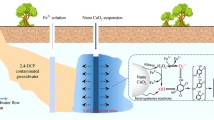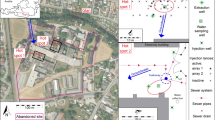Abstract
The purpose of this study is to examine the development and effectiveness of a persistent dissolved-phase treatment zone, created by injecting potassium permanganate solution, for mitigating discharge of contaminant from a source zone located in a relatively deep, low-permeability formation. A localized 1,1-dichloroethene (DCE) source zone comprising dissolved- and sorbed-phase mass is present in lower-permeability strata adjacent to sand/gravel units in a section of the Tucson International Airport Area (TIAA) Superfund Site. The results of bench-scale studies conducted using core material collected from boreholes drilled at the site indicated that natural oxidant demand was low, which would promote permanganate persistence. The reactive zone was created by injecting a permanganate solution into multiple wells screened across the interface between the lower-permeability and higher-permeability units. The site has been monitored for 9 years to characterize the spatial distribution of DCE and permanganate. Permanganate continues to persist at the site, and a substantial and sustained decrease in DCE concentrations in groundwater has occurred after the permanganate injection. These results demonstrate successful creation of a long-term, dissolved-phase reactive treatment zone that reduced mass discharge from the source. This project illustrates the application of in situ chemical oxidation as a persistent dissolved-phase reactive treatment system for lower-permeability source zones, which appears to effectively mitigate persistent mass discharge into groundwater.





Similar content being viewed by others
References
Conestoga-Rovers & Associates (2003). Final Samsonite building area and west end of runway 3 shallow groundwater zone (SGZ) remedy technical memorandum. CRA, Phoenix, AZ.
Borden, R. C. (2007). Concurrent bioremediation of perchlorate and 1,1,1-trichloroethane in an emulsified oil barrier. Journal of Contaminant Hydrology, 94(1–2), 13–33.
Brusseau, M. L., Nelson, N. T., Zhang, Z., Blue, J. E., Rohrer, J., & Allen, T. (2007). Source-zone characterization of a chlorinated-solvent contaminated superfund site in Tucson, AZ. Journal of Contaminant Hydrology, 90, 21–40.
Brusseau, M. L., Carroll, K. C., Allen, T., Baker, J., DiGuiseppi, W., Hatton, J., Morrison, C., Russo, A., & Berkompas, J. (2011a). The impact of in-situ chemical oxidation on contaminant mass discharge: linking source-zone and plume-scale characterizations of remediation performance. Environmental Science and Technology, 45, 5352–5358.
Brusseau, M. L., Hatton, J., & DiGuiseppi, W. (2011b). Assessing the impact of source-zone remediation efforts at the contaminant-plume scale: application to a chlorinated-solvent site. Journal of Contaminant Hydrology, 126, 130–139.
Brusseau, M. L., Matthieu, D. E., III, Carroll, K. C., Mainhagu, J., Morrison, C., McMillan, A., Russo, A., & Plaschke, M. (2013). Characterizing long-term contaminant mass discharge and the relationship between reductions in discharge and reductions in mass for DNAPL source areas. Journal of Contaminant Hydrology, 149, 1–12.
Coulibaly, K. M., & Borden, R. C. (2004). Impact of edible oil injection on the permeability of aquifer sands. Journal of Contaminant Hydrology, 71(1–4), 219–237.
Durmusoglu, E., & Corapcioglu, M. Y. (2000). Experimental study of horizontal barrier formation by colloidal silica. Journal of Environmental Engineering-Asce, 126(9), 833–841.
Harbaugh, A.W., Banta, E.R., Hill, M.C., McDonald, M.G. (2000). MODFLOW-2000, The U.S. geological survey modular ground-water model-user guide to modularization concepts and the ground-water flow process. Open-File Report 00–92. Reston, Virginia.
Heiderscheidt, J. L., Siegrist, R. L., & Illangasekare, H. (2008). Intermediate-scale 2D experimental investigation of in situ chemical oxidation using potassium permanganate for remediation of complex DNAPL source zones. Journal of Contaminant Hydrology, 102(1–2), 3–16.
Hood, E. D., Thomson, N. R., Grossi, D., & Farquhar, G. J. (2000). Experimental determination of the kinetic rate law for the oxidation of perchloroethylene by potassium permanganate. Chemosphere, 40(12), 1383–1388.
Huang, K. C., Hoag, G. E., Chheda, P., Woody, B. A., & Dobbs, G. M. (2001). Oxidation of chlorinated ethenes by potassium permanganate: a kinetics study. Journal of Hazardous Materials, 87(1–3), 155–169.
Johnson, G. R., Zhang, Z., & Brusseau, M. L. (2003). Characterizing and quantifying the impact of immiscible-liquid dissolution and nonlinear, rate-limited sorption/desorption on low-concentration elution tailing. Water Resources Research, 39(5), 6–1–6–8.
Johnson, G. R., Norris, D. K., & Brusseau, M. L. (2009). Mass removal and low-concentration tailing of trichloroethene in freshly-amended, synthetically-aged, and field-contaminated aquifer material. Chemosphere, 75(4), 542–548.
Johnson, K.T., Wickham-St. Germain, M., Ko, S., Huling, S.G. (2012). Binary mixtures of permanganate and chlorinated volatile organic compounds in groundwater samples: sample preservation and analysis. Groundwater Monitoring & Remediation, 32(3), 84–92. doi:10.1111/j.1745-6592.2011.01385.x.
Marble, J. C., Carroll, K. C., Janousek, H., & Brusseau, M. L. (2010). In situ oxidation and associated mass-flux-reduction/mass-removal behavior for systems with organic liquid located in lower-permeability sediments. Journal of Contaminant Hydrology, 117(1–4), 82–93.
McCartney, J., Nogueira, C. L., Homes, D., & Zornberg, J. G. (2011). Formation of secondary containment systems using permeation of colloidal silica. Journal of Environmental Engineering-Asce, 137(6), 444–453.
Mumford, K. G., Lamarche, C. S., & Thomson, N. R. (2004). Natural oxidant demand of aquifer materials using the push-pull technique. Journal of Environmental Engineering, 130, 1139–1146.
Seol, Y., Zhang, H., & Schwartz, F. W. (2003). A review of in situ chemical oxidation and heterogeneity. Environmental & Engineering Geoscience, 9(1), 37–49.
Whillier, S. (2004). CRA, Inc, Phoenix, AZ. Personal communication.
Zheng, C., Wang, P.P. (1999). “MT3DMS: a modular three-dimensional multispecies transport model for simulation of advection, dispersion, and chemical reactions of contaminants in groundwater systems; documentation and user’s guide,” Contract Report SERDP-99-1, US Army Engineer Research and Development Center, Vicksburg, MS.
Acknowledgments
This research was supported by the Tucson Airport Authority (TAA), with additional support provided by the US Department of Defense Strategic Environmental Research and Development Program (ER-1614) and the National Institute of Environmental Health Sciences Superfund Research Program (ES04940). We thank the several U of A students and staff that provided field and laboratory assistance. We thank the reviewers for their comments.
Author information
Authors and Affiliations
Corresponding author
Rights and permissions
About this article
Cite this article
Marble, J.C., Brusseau, M.L., Carroll, K.C. et al. Application of a Persistent Dissolved-Phase Reactive Treatment Zone for Mitigation of Mass Discharge from Sources Located in Lower-Permeability Sediments. Water Air Soil Pollut 225, 2198 (2014). https://doi.org/10.1007/s11270-014-2198-0
Received:
Accepted:
Published:
DOI: https://doi.org/10.1007/s11270-014-2198-0




